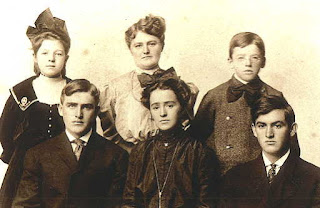Try to take a fast drive through Ladoga, and I guarantee that you will slow down to gaze at some of the beautiful late 19th century homes that grace its streets. Maybe you’ll wonder about who must have built all that beauty. A local man, Hiram Huntington, and several partners, including his son, George, were responsible for bringing about the peaks, the porches, the gingerbread, and the fish scale siding on many of these homes. Hiram Huntington was the best builder in the county beginning in 1866 and continuing on for fifty years! He started out as a trainman in 1859 in New Albany, Indiana, on the Monon Railroad, then during the Civil War he worked as a pattern maker in Nashville, Tennessee, making armament for the Union forces. After the war, he moved his family to Ladoga, and began making his mark on Montgomery County.
 |
| from CDPL image database |
Probably the most visible and well-known building he and his son, George, completed was the Ladoga East Graded School (1897). What a grand looking school with its ornate brickwork, half-round windows, and lofty turrets mounted on each corner! This school was used for seventy-five years!
 |
J. C. Knox home, Ladoga, 1895
http://streetsofladoga.blogspot.com/ |
One home that he built, the Ashby home, south of Ladoga, is on the National Register of Historic Places. The J. C. Knox home, in Ladoga, is a quintessential example of Victorian architecture. Hiram, despite his poor eyesight, was responsible for making much of the elaborate woodwork found inside and outside many of the houses he built.
A funny note about the family--Hiram and Sarah Gregg married on February 14, 1858. Their two sons were also born on Valentine’s Day--George in 1867, and Harry in 1869!
 |
| George (2nd row, with moustache) in his Ladoga High School picture (ca. 1885) |
So, the next time you take a slow drive through Ladoga, think about this influential and talented family, the Huntingtons.
(Information from "Family Histories, Montgomery County, 1823-1988." Compiled by the Genealogy Sect. of the Montgomery County Historical Society, 1989)





































